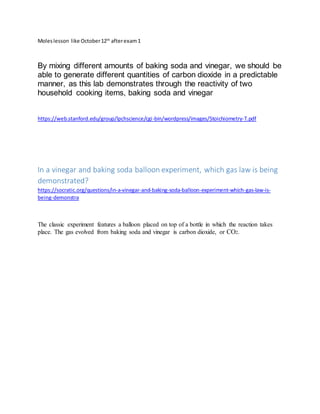Moles lesson like october 12th after exam 1 new new
- 1. Moleslesson like October12th afterexam1 By mixing different amounts of baking soda and vinegar, we should be able to generate different quantities of carbon dioxide in a predictable manner, as this lab demonstrates through the reactivity of two household cooking items, baking soda and vinegar https://web.stanford.edu/group/lpchscience/cgi-bin/wordpress/images/Stoichiometry-T.pdf In a vinegar and baking soda balloon experiment, which gas law is being demonstrated? https://socratic.org/questions/in-a-vinegar-and-baking-soda-balloon-experiment-which-gas-law-is- being-demonstra The classic experiment features a balloon placed on top of a bottle in which the reaction takes place. The gas evolved from baking soda and vinegar is carbon dioxide, or CO2.
- 2. http://frugalfun4boys.com/2011/11/10/blow-up-a-balloon-with-baking-soda-and-vinegar/ Assuming your reaction takes place at constant pressure and temperature (in the chemistry lab or at home), the increasing quantity of gas produced will determine the volume of the balloon to increase as well.
- 3. http://frugalfun4boys.com/2011/11/10/blow-up-a-balloon-with-baking-soda-and-vinegar/ Stoichiometry: Baking Soda and Vinegar Reactions
- 4. https://web.stanford.edu/group/lpchscience/cgi-bin/wordpress/.../Stoichiometry-T.pdf Students know how to apply the gas laws to relations between the pressure, ... By mixing different amounts of baking soda and vinegar, we should be able to ...




